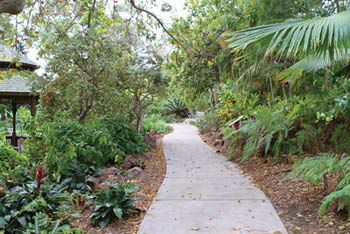
Beautiful San Diego Gardens
San Diego’s temperate climate, with its weather of eternal spring, continues to lure international visitors and transplants alike, while treating residents to the local alfresco lifestyle; the abundance of outdoor living and cultural diversity are undeniably our greatest of treasures. And in true Southern California form, our garden landscape blossoms throughout the year, unveiling the expression of their very existence; a form that simply stems from their aesthetic, historical and environmental significance.
San Diego Botanical Gardens
Formerly the Quail Botanical Gardens, the San Diego Botanic Gardens is a frost-free habitat of fruit bearing sub-tropical trees and native California plants. 37 acres unfold four miles of trails offering secret gardens of rare bamboo collections, fire-safe landscaping, and growing herbs. And in continuing to expand its outreach, the Hamilton Children’s Garden was opened in mid-2009; specifically designed for children, the exhibit has become the largest interactive garden on the west coast.
I like that nature is interactive here," states Charista Eillers, mother of a 6-year-old boy and recent garden patron. "[My son] loves to use his imagination. [And] we love the Garden of Lights too."
A non-profit entity, the Botanical Gardens serve as an education site in horticultural and botanical preservation. The site, once a private estate of exotic plants from around the world, was the residence of Ruth and Charles Larabee; the estate was bequeathed to the County of San Diego in 1971, opening the gardens to the public.
Balboa Park, San Diego
Through its entrance on Laurel Street, visitors are welcomed to the ever-famed Balboa Park – much like the experience of entering the Prado in Toledo, Spain. The rich culture of art, beauty and architecture of 15 world-class museums, theaters, and more than eight diverse, lushly landscaped gardens – are essential to the historical fabric of San Diego’s landscape; spanning 1,200 acres in Hillcrest, the park was originally landscaped for the 1915-16 Panama-California Exposition, featuring Spanish-Renaissance architecture, fountains and foyers.
Popularized for its fronted Lily pond, the Botanical Building remains one of the most photographed and historic within the park; also noted as one of the largest lath structures in the world. Home to a growing collection of more than 2,100 species of permanent tropical plants, ferns, orchids and palms, the display also features seasonal flower arrangements as well.
Serene and tranquil, the Japanese Friendship Garden – neighboring the Spreckels Organ Pavilion – originated as a teahouse in the early 20 century; the two acre garden extends a Zen garden for meditation and koi pond, a bonsai exhibit and a Fujidana (wisteria arbor) – a balanced composition featuring specifically placed stones, water, plants and trees purposed for meditation and repose. Under the direction of Professor Takeo Uesugi, a stone placement specialist, outdoor space is currently expanding 11 acres to include a traditional teahouse, a pavilion for 300 patrons, an outdoor amphitheatre and wheelchair accessible paths. Weekend classes are available, offering sushi making, bonsai, calligraphy, and conversational Japanese; in addition, licensed practitioners from Japan host traditional tea ceremonies, free with admission.
According to Dominique Jordan, a Swiss resident on a world journey who recently visited the Friendship Garden, "I have been all over Asia, and never have I seen a tea ceremony" – simply noting the value of the garden’s outreach.
The Flower Fields at Carlsbad Ranch
Resting along the hillside slopes of central Carlsbad, rows of rainbow ranunculus’ in The Flower Fields (an All American Rose Selection (AARS) accredited public garden) elicit a scent much like that of the poppy fields in the "Wizard of Oz." With 50 acres of blooms, the "Fields of Color" attract more than 125,000 visitors annually for 10 weeks each spring.
Floral cultivation by Luther Gage in the early 1920s, followed by Frank Frazee and his son Edwin, has for 85 years produced full flowers in 13 colors, including picotee – a mixture of variegated colors. In the 1950s, Frazee was the only commercial ranunculus grower in the U.S. – he was able to successfully cultivate the single petal into an unprecedented double. In knowing the popularity of the fields, Edwin once stated, "If I had one penny for every picture that’s been taken of those fields, I’d be a rich man."
Paul Ecke Jr. (Ecke Poinsettias) formed a joint venture with grower Mellano and Company in 1993 when Frazee retired. The fields are dedicated to beauty, and the built-in tourist attraction supports the financial needs. A retail agreement with Armstrong Gardens on site has made available seeds and plants for a ‘pocketful of posies’ to take home. The fields are in bloom March through May.
According to Fred Clarke, general manager of the ranch, "We invite visitors to spend a day at the Flower Fields, it’s like an outdoor spa where your senses are stimulated, exercise is a beautiful walk, the water tastes sweeter as you look at the ocean views and you relax in a field of color unlike anything you might have seen or done before."



(0) comments
We welcome your comments
Log In
Post a comment as Guest
Keep it Clean. Please avoid obscene, vulgar, lewd, racist or sexually-oriented language.
PLEASE TURN OFF YOUR CAPS LOCK.
Don't Threaten. Threats of harming another person will not be tolerated.
Be Truthful. Don't knowingly lie about anyone or anything.
Be Nice. No racism, sexism or any sort of -ism that is degrading to another person.
Be Proactive. Use the 'Report' link on each comment to let us know of abusive posts.
Share with Us. We'd love to hear eyewitness accounts, the history behind an article.